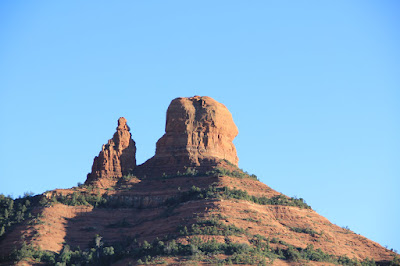
The USS Midway is an immense aircraft carrier that was a key part of the US Navy from 1946 to 1992. Now, moored at San Diego, it is a vast floating museum which gives the public a glimpse into the realities of Navy life, recent military history, and the constantly developing military hardware on board. This museum was really impressive, but also left us with a sense that something was slightly wrong too.

A link in the great anchor chains that held all 74,000 tons of the ship in place.

On the way into the ship visitors are given a headset for the audio tour. This provides a detailed and fascinating commentary on every aspect of the vessel, from the bridge with its command and control systems, to the engine rooms, the living areas, decks and even the brig. Even better than the recorded information were the live talks from former sailors and pilots about life on board - and the technical difficulties of landing planes on a moving boat in a high sea. Their experiences of the various aircraft were good to hear too, although I seemed to find their recollections of combat more chilling than exultant.

The ship's unusually long active life meant that it experienced several re-designs to cope with the changing needs of the aircraft it served. The vast 'slewed' runway was, for instance, not original. The first places that flew from its decks in the 1940s were, of course tiny piston-engined fighters; but the history doesn't stop there - planes representing each era of the ship's operation life are also displayed. Some of these aircraft are truly beautiful, sleek structures, with power inside them as raw as their shape is graceful. Underneath their wings of course, they are bristling with weaponry...

And this is where we began to feel a little uneasy. There was such an overpoweringly gung-ho attitude about war, about conflict and about America's undisputed right to use force where and when it liked, that I felt slightly agitated. The attitude that every single US military intervention over the last 60 years has been without doubt right, good, moral and necessary; seemed to be the requirement to glory in every new development in technology described. There was no sense of critical self-reflection, no glimmer of pity for the enemy or their families, no questioning whether (for instance) Nixon's plan to bomb the crap out of the North Vietnamese cities was right, or criminal. Sadly, there was not even a humble sense that all this firepower was a sad necessity in a mixed-up dangerous world. Rather, there was a rejoicing in the ability to kill which I found unnerving, perplexing and difficult.

The movie "Top-Gun" is appalling on many levels (they quote it with great affection on the Midway though). The most dreadful aspect of the film is that while the death and loss of white Americans is mourned in the context of family, friendship and grief; every Asian looking, Mig-flying communist that goes down, descends to their death with cheers - and is forgotten. They are presented as "other"; they do not matter, they have no humanity, no back-story, no family, no friends, and so their deaths can be hoorah'd as the triumph of American bravery and skill. If this is not offensive film-making I find it hard to imagine what is. Yet, for many of our guides, in their reminiscences and in several of the audio and visual presentations we heard - history according to 'top-gun' is all we got.
Now this is worrying. Don't misunderstand me, I am not for one moment suggesting that all US interventions have been wrong (they haven't). The Midway was active, for example in the First Gulf War, a war in which there was no question of the legality of the combat operations it undertook to liberate Kuwait. Nor am I suggesting that a revival of extreme isolationism by the USA is in anyone's interests, least of all their own. What I am saying is that there is an urgent need for more reflective, critical public discourse than the simple regurgitation of the 'my country right or wrong' myth that is allowed at places like the Midway.
If you are willing to get swept along by the jingoism of the presentation; then this kind of one-sided view of history will make the heart swell with pride, bring a tear to the eye and flag raised skyward. On the other hand, if you are left thinking that you are only being told a fraction of the story - it starts to make you doubt the bits you are being told.
This is a great museum, and an excellent (and good value!) day out for the family too. The guides are knowledgeable and friendly, and it does open up some important aspects of the recent past. A little more mature debate, less flag-waving and honesty about the past, and about the horror of war and killing would make this a great deal better though.


















































